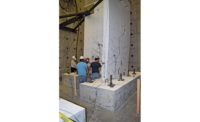The Charles Pankow Foundation is about to begin a nearly $27- million fund-raising campaign to support unprecedented research in high-strength reinforcing steel. The goal of the five-year research program is to simplify and speed reinforced-concrete construction by easing rebar congestion. The program would provide the scientific basis for the first major overhaul of the concrete building standard in 50 years.
"This project has the potential to change engineering practice in a significant way," says Jon A. Heintz, director of projects for the Applied Technology Council, which is managing the research project, called ATC 115: Road Map for the Use of High-Strength Reinforcement in Reinforced Concrete Design, under a $191,530 grant from the Pankow foundation. Pankow released the 95%-complete draft of the ATC 115 report on Oct. 27.
"High-strength reinforcing steel also provides the opportunity to improve construction efficiencies," thanks in large part to reduced material needs, rebar congestion, labor and cycle time per floor, says Heintz. "The long-term benefits come on the construction side, where all the big dollars are spent."
The road map includes a detailed list of the steps necessary to update the American Concrete Institute's ACI 318-14: Building Code Requirements for Structural Concrete and Commentary to allow the general use of rebar—in walls, columns, beams and slabs—with a yield strength of up to 100 ksi, even for special seismic zones.
Nearly every chapter of ACI 318 will be affected by the research, says Dominic J. Kelly, a structural-engineer partner with Simpson Gumpertz & Heger and ATC 115's project technical director.
There hasn't been targeted research to support a code change since the late 1960s, when the standard minimum yield strength for rebar jumped to 60 ksi from 40 ksi, or Grade 40. Most of the U.S. code is based on research on lower-strength concrete. Currently, engineers more routinely specify higher strengths, from 8,000 psi to 14,000 psi and greater.
Grade 80 rebar has been in the code for gravity systems since 1971. However, engineers in highly seismic zones, such as the West Coast, are limited by the code to the use of 60 ksi.
Research Goals
By the end of next year, the goal is to complete research to revise the ASTM A615 specification to include Grade 100 rebar in time for 2016 interim provisions for ACI 318. That will increase the demand for the material, which "will then provide an opportunity for material producers to refine their metallurgy and manufacturing processes to better meet requirements (e.g., ductility and tensile-to-yield strength ratios) related to engineering needs associated with the development of Grade 100 reinforcement for seismic and other applications," says the report.
The ultimate goal is to change the ACI 318 code to allow use of 100 ksi in all systems, which could take several years. The target is the 2022 version of the code.
"I am excited by the program but also frustrated about how long it will take to change the code," says Ron Klemencic, chairman and CEO of structural engineer Magnusson Klemencic Associates, who serves on Pankow's board of directors.
The 39 research projects outlined cover rebar production and specification, member strength, serviceability, reinforcing limits, detailing, general considerations for analysis and earthquake resistance. The report is available for free at www.pankowfoundation.org/ATC115.







Post a comment to this article
Report Abusive Comment